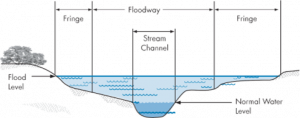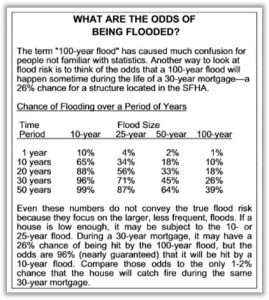Floodplains
Like New Orleans, much of Old Town, downtown Albuquerque, and the Valley are below the level of the Rio Grande. This is because the river drops sediment over time, raising the riverbed. In the past, the river would eventually rise high enough that it would begin to take another path, gradually building up that new riverbed with sediment. This was not a problem until people began building in the lowlands near the river.
Beginning in the 1930s, levees were built along the river to keep the Rio Grande in its current riverbed. Additional levees were built in the 1950s and in 1997. Since the riverside levees were built, the Rio Grande has not been able to make periodic course changes. Stormwater in the low-lying areas of town is drained with the assistance of large pumps that lift the water into the Rio Grande. Unless protected by a certified levee, FEMA considers land in many of those low-lying areas to be in a floodplain.
Localized flooding (during and immediately after a heavy rainstorm) may also occur in any part of town. This may or may not mean the property is in a floodplain.

What is a Floodplain?
The Federal Emergency Management Agency (FEMA)
The Federal Emergency Management Agency (FEMA) is part of the U.S. Department of Homeland Security (DHS). The primary mission of FEMA is to “reduce the loss of life and property and protect the Nation from all hazards, including natural disasters, acts of terrorism, and other man-made disasters, by leading and supporting the Nation in a risk-based, comprehensive emergency management system of preparedness, protection, response, recovery, and mitigation.”
FEMA also determines flood zones, which in turn determine the need for flood insurance.
Types of flooding
Flood Insurance
Flood insurance is required for real property which FEMA has determined to be in a floodplain.
To find out more on flood insurance, please visit, the:
Emergency Management
-
-
City of Albuquerque – Emergency Managment
Sign up for emergency alerts and community notifications from the City of Albuquerque.
-
Resources:
- City of Albuquerque Floodplain Development
- Bernalillo County Flood Zone Information
- FEMA National Flood Hazard
- NMFlood.org
- National Flood Insurance Program
- New Mexico Floodplain Managers Association
- Southern Sandoval County Arroyo Flood Control Authority
- Eastern Sandoval County Arroyo Flood Control Authority


